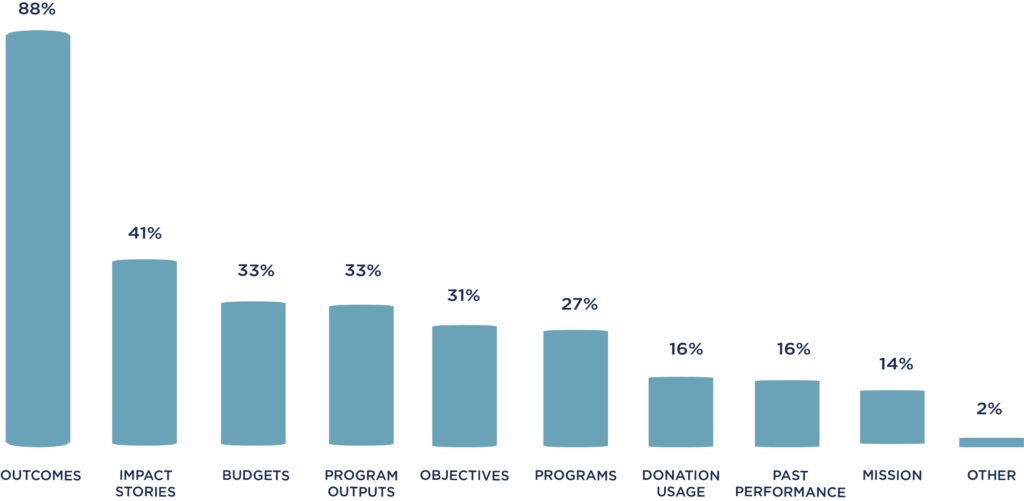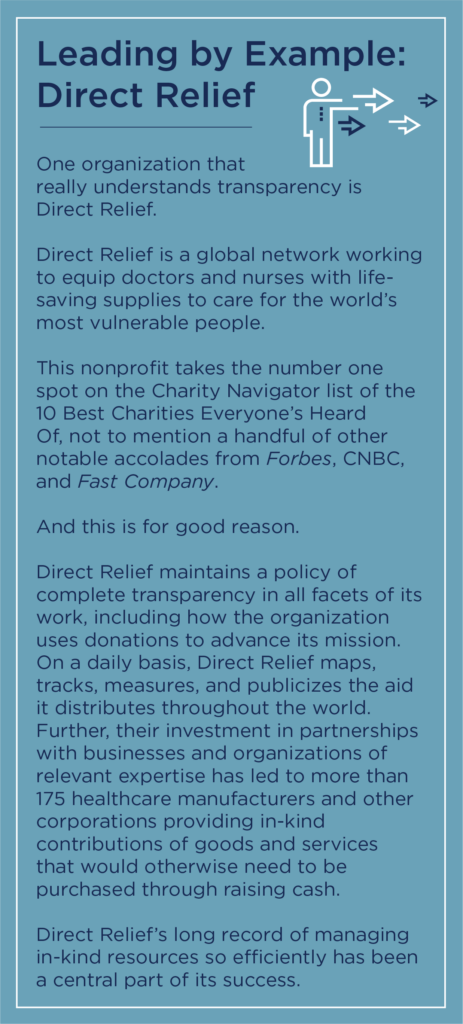Transparent Reputations and Nonprofit Organizations
The Puritans required adulterers to wear a scarlet letter A as a penance for their wrongdoing. It was a visible symbol of misconduct meant to stigmatize the wearer and warn off others. For nonprofit organizations, a reputation lacking honesty, integrity, and transparency is a similar penance. It marks them as untrustworthy and limits their ability to successfully engage donors.
No longer is the word charity synonymous with virtue and integrity. Nonprofits beware. Comply, or wear a scarlet letter for lacking the ethical principles and accountability engrained in true nonprofit transparency.
Trust Issues
There is a thread that exists between transparency and profit, and that delicate strand is made of trust. Unfortunately, scandals around the mismanagement of donors’ gifts—including bloated executive salaries, board mismanagement, corruption, and massive amounts of money paid out to third-party fundraising outfits—have left today’s donors questioning the authenticity of benevolent organizations.
“When an endowment or a foundation is less than forthright, it puts a blemish on the entire nonprofit community,” says Eric Bailey, head of the endowments and foundations practice at CAPTRUST. “Sometimes it’s out-and-out fraud. Other times, it’s a lack of leadership, misalignment, or lack of mission. Nonetheless, it’s damaging.”
According to the give.org “Donor Trust Report,” 32 percent of respondents trust charities less today than they did five years ago. And 73 percent of respondents to a separate survey rated the importance of trust as nine or 10 on a 10-point scale, with only 20 percent of those respondents indicating a high level of trust in charities.
Further, about a third of Americans don’t trust charities to spend their money well, and more than 60 percent of people around the globe say they don’t have faith that nonprofits can accomplish their missions, Fast Company reports.
The public has higher expectations for organizations whose missions are to do good. “Today, people want to know more about a nonprofit’s mission, its goals, its impact, and the outcomes produced. Donors want access to detailed financial reporting, too,” says Bailey.
The fact is, donors are doing their homework before making gifts. And, according to data from The NonProfit Times, if a nonprofit organization doesn’t live up to a certain standard of transparency, it receives 47 percent less in contributions than organizations that proactively provide data to the public.
“By committing your agency to a donor bill of rights, those donors have the opportunity for transparency,” says Kristye Brackett, vice president of philanthropy at Transitions LifeCare.
Created by the Association of Fundraising Professionals, the Association for Healthcare Philanthropy, the Council for Advancement and Support of Education, and the Giving Institute: Leading Consultants to Non-Profits, the Donor Bill of Rights assures that a nonprofit organization deserves the respect and trust of the general public, and that donors and prospective donors can have confidence in the charities and causes they support.
“[At Transitions LifeCare], we are constantly having conversations about what does the donor bill of rights look like, and what are we doing to really adhere to that donor bill of rights,” says Brackett.
The More You Give, the More You Get
Don’t give donors reason to distrust your organization. Safeguard against this by making your organization’s financials easy for the public to find.
Nonprofits that are more transparent and share things publicly, like audited financial reporting, goals, strategies, capabilities, and metrics demonstrating progress and results, received 53 percent more in contributions compared with organizations that are less transparent. This is also according to The NonProfit Times.
A separate study published by the Journal of Accounting, Auditing & Finance, titled “Determinants and Consequences of Nonprofit Transparency,” hypothesized and found to be true that the decision to be transparent equates greater future contributions.
“When an organization provides insight into how donations are used, it adds depth and breadth to the mission that could not be gained in any other way,” says Bailey.
Current reporting provided by nonprofits detailing how donations are being used is expected to stay about the same or increase over the next five years. As shown in Figure One, however, donors are most interested in hearing about program outcomes (88 percent) and impact stories (41 percent).
Figure One: What Areas of Nonprofits Are Donors Interested in Learning About?

Source: “Foundation Reporting Study,” Social Solutions, 2019
Make Your Impact Known
Donors are motivated to understand who, where, and what their charitable gifts will support. Understanding how an organization demonstrates its impact is important to donors. In other words, they want to know who a nonprofit is helping, how the organization is helping them, and exactly how their gift was used.
“We know savvy people are doing their due diligence before they come to the table,” says Brackett. “Donors expect to see low administrative costs per dollar raised, with the greatest impact going back to service needs.”
As shown in Figure Two, 98 percent of donors ranked impact as the most important factor when considering making a charitable donation, followed by mission (49 percent) and legal nonprofit status (37 percent).
“In every donor conversation, we tie it back to what their dollar is impacting in the service line. We do that in not only our larger gift asks but also in our annual appeals and our thank-you notes. And we hold to the standard that the [IRS Form] 990 reflects back on that. It is spelled out in all of our materials,” says Brackett.
Figure Two: Impact Is the Most Important Consideration Among Donors

Big Brother is Watching
Fortunately for donors, there are watchdog organizations like the Better Business Bureau Wise Giving Alliance, the American Institute of Philanthropy, CharityWatch, and GuideStar, whose goal is to help inform donors by grading, monitoring, and measuring how donations flow into and out of nonprofits in relation to the goal they report. These organizations are in the business of advancing nonprofit transparency by gathering, organizing, and distributing information about U.S. nonprofits. Donors leverage these organizations to help them consider various aspects of a nonprofit’s transparency.

In a report examining if the GuideStar Seal of Transparency had an effect on fundraising, organizations with the seal were shown to be more likely to receive donations than those that had only claimed their profiles and opted to receive contributions through GuideStar. And 78 percent of the organizations that received a donation through GuideStar’s website last year were seal holders.
Depending on how much information a nonprofit provides in its GuideStar profile, the organization is identified by a specific seal that indicates its level of commitment to transparency. There are four levels; the more information provided, the higher the level Seal of Transparency awarded.
Bronze is for basic information, silver indicates full financial information has been shared, and gold means that the organization has shared all of these plus its goals and strategy. Finally, the highest seal is platinum, which indicates everything aforementioned, in addition to proven progress and results.
“Having that GuideStar Platinum Seal of Transparency is something each endowment or foundation should strive for. Donors are definitely reassured by it,” says Bailey.
Which seal an organization earns is incredibly important to potential donors. GuideStar reports that, in general, profiles with gold or platinum seals receive twice the views of other profiles. And the average donation for gold and platinum seal holders is roughly 11 percent higher than the combined average donation for non-seal holders or organizations with bronze and silver seals. Additionally, the combined average donation for all seal holders was 7 percent higher than that for non-seal holders.
Transparency Drives Traction
Charitable organizations are not powerless in shaping public perceptions about the nonprofit sector. Luckily, the dynamic nature of trust suggests the third sector can make changes that positively impact public opinion.
Transparency is not just about releasing a box of documents for public consumption. It can be a real tool for nonprofits to increase their impact through more accurate self-assessments and public engagement, leading to increased donations, more volunteers, and more positive press.
Another key piece to understand: Transparency is not a one-size-fits-all equation. What is comfortable for one organization may not be comfortable, realistic, or appropriate for another. The best transparency policy will be one guided by an organization’s mission, catered to its supporters and potential supporters, and considerate of the organization’s needs, policies, and legal issues.
“Establish great mission work that’s held accountable back to philanthropic investments. Rely on that philanthropic investment as an up-lifter of your mission and treat it very seriously,” shares Brackett. “And with that treatment and transparency, there will be more. People want to give. They are generous.”